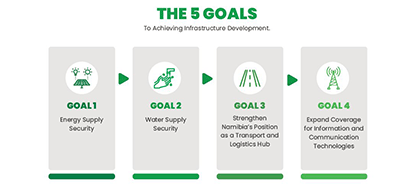Staff Reporter
The Harambee Prosperity Plan II (HPP II) covers 2021 to 2025 and builds on the solid foundation of the inaugural HPP 2016-2020. It continues to prioritise the implementation of targeted policy programmes to enhance service delivery, contribute to economic recovery and engender inclusive growth.
HPPII aims to ensure Namibia is poised to respond to domestic socioeconomic challenges and global opportunities during and after the Covid-19 pandemic.
The formulation of HPPII involved a process of extensive literature review, workshops with subject matter experts and countrywide stakeholder consultations, including the 2019 Town Hall Meetings. The baseline for these consultations was the HPP Final Report (2016-2020) and contemporary developmental issues.
The HPPII remains a targeted Impact Plan, consisting of prioritised short to medium term goals and strategic actions to accelerate national development towards Vision 2030 and Prosperity for All.
The HPPII retains the five pillars, namely:
Pillar 1: Effective Governance
Pillar 2: Economic Advancement
Pillar 3: Social Progression
Pillar 4: Infrastructure Development
Pillar 5: International Relations and Cooperation
The HPP Pillars remain firmly anchored on the construct of an inclusive Namibian House, built on the solid foundation of peace, stability and the rule of law.
Pillar Four: Infrastructure Development
Infrastructure development is a catalyst for economic growth, social progression and contributes significantly to global competitiveness and investment attraction. It is a key enabler to unlock development in local and regional jurisdictions.
On this basis, Namibia has sustained investments in infrastructure, such as transportation (roads, rail, ports and airports), energy, water and technology.
In light of the unprecedented financial and economic climate, exacerbated by the onset of the Covid-19 pandemic, the role of government and stakeholders in infrastructure development will be more collaborative during HPPII.
Namibia has to date ranked well in “hard’’ economic infrastructure like roads, rail, ports and airports in African rankings and some elements (e.g. roads, ports) in global rankings. However, there is scope for improvement in “soft’’ infrastructure rankings.
These include both social and educational indicators (generally below the top 100) and critical indicators such as the Global ICT Index (118) and Global Cybersecurity Index (141). While traditional infrastructure elements will be further enhanced by leveraging private and PPP funding, HPPII endeavours to elevate the development of social, health and education as high priority areas, in partnership with the private sector through the Public-Private Partnership (PPP) framework.
HPPI focused on four (4) core sub-pillars for infrastructure development, namely: Energy, Water, Transport and ICT. While significant progress was achieved in several desired outcomes, some were not achieved due to a combination of factors, including inadequate public sector capacity, funding and insufficiently progressed policy frameworks to facilitate private investment and PPPs.
This Pillar has 4 goals:
Energy Supply Security
Water Supply Security
Strengthen Namibia’s Position as a Transport and Logistics Hub
Expand Coverage for Information and Communication Technologies
The four Goals are positioned to achieve better outcomes in HPPII, through a more collaborative partnership approach, consulted and agreed-upon outcomes to be delivered by partners. The core physical pillars of infrastructure have been the focus of HPPI and the NDPs will continue to receive sustained attention under HPPII.
Considering limitations on public funding and the global trend to sharing infrastructure development through Private Sector Participation (“PSP’’) and PPP formats, the government aims to facilitate an improved partnership approach by leveraging off-balance sheet funding and technology sources.
The assessment of the Infrastructure Development Pillar during HPPI points to an achievement of 67%; out of 15 desired outcomes, 10 were on target. The government is committed to completing the ongoing activities under HPPII.
Activities under this Pillar rely on a renewed investment drive and elevated private sector and PPP commitment to infrastructural development, as well as mobilising capital markets – local and international – for infrastructure funding and notably for “green and blue’’ infrastructure.
The Public-Private Partnership Act and Public Enterprise Governance Act are promulgated and the critical energy frameworks are being operationalised. These include the National Integrated Resource Plan, Independent Power Producer Policy, Renewable Energy Policy, National Energy Policy (replacing the White Paper on Energy Policy) and the Modified Single Buyer Model Framework. Cabinet has approved the new Electricity Bill and Energy Regulator Bill due to be enacted during HPPII. All of these are enablers to a new format of shared infrastructure development.
GOAL 1: Secured and cost-effective energy supply
Increasing local electricity generation capacity from 624 MW (2020) to 879 MW by 2025
Electrify 6 000 rural and 13 000 peri-urban households by the end of HPPII.
Electrify 213 new schools and health facilities by the end of HPPII.
Achieving greater coordination to unlock national energy potential
GOAL 2: Secured and cost-effective water supply
Securing access to water for human consumption and industrial activities
GOAL 3: Strengthening Namibia’s position as a transport and logistics hub,
Completion of ongoing bitumen roads.
Complete refurbishment and upgrading of the Tsumeb-Walvis Bay railway line to SADC standard by 2025
GOAL 4: Universal coverage to information and communications technologies
Implement ‘Open Access Network’ infrastructure sharing regime in a bid to champion Universal Broadband Access by 2025.
Facilitate a safe and robust ICT ecosystem
Attain 95% Digital Television broadcasting network to all Namibian households.


